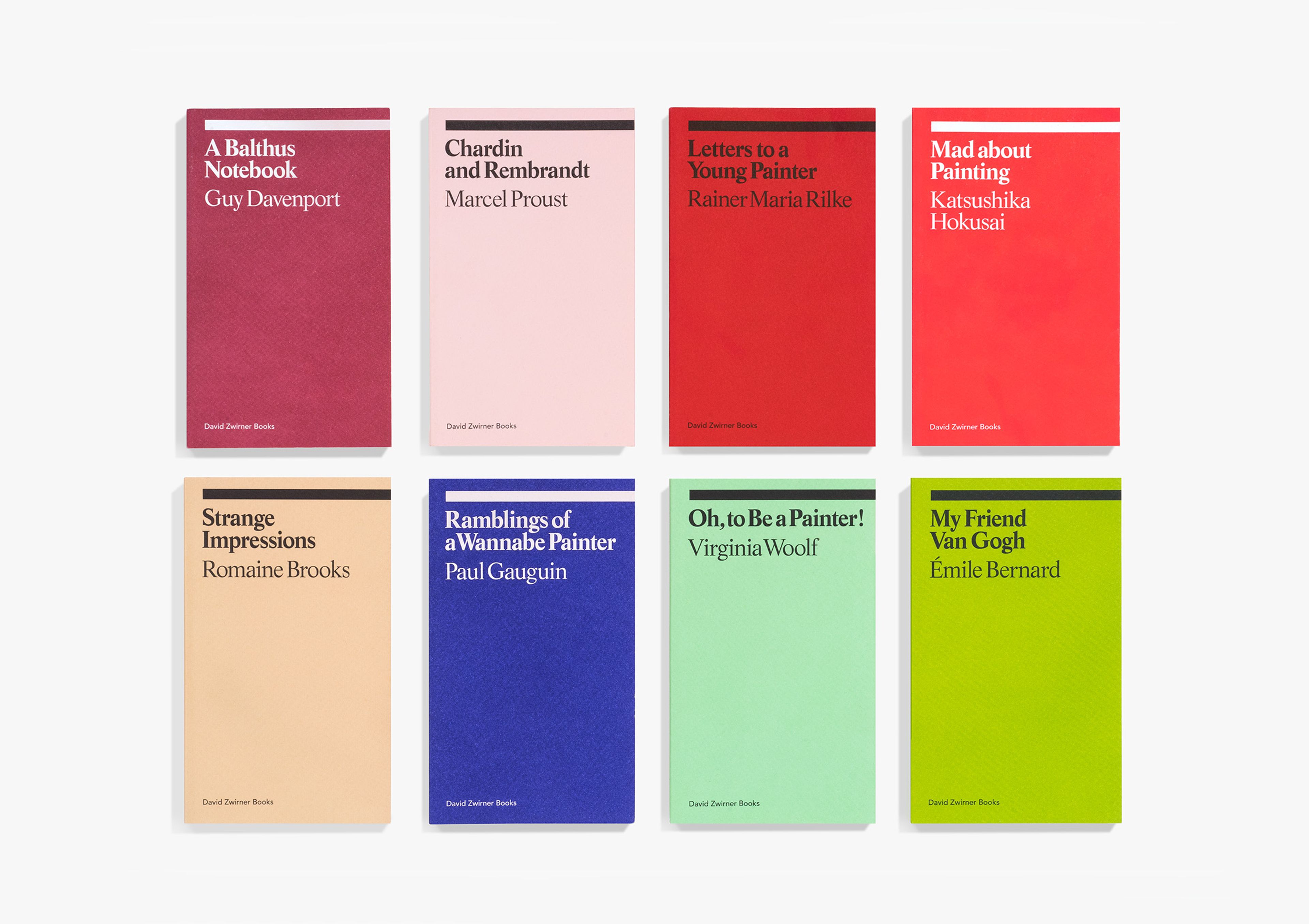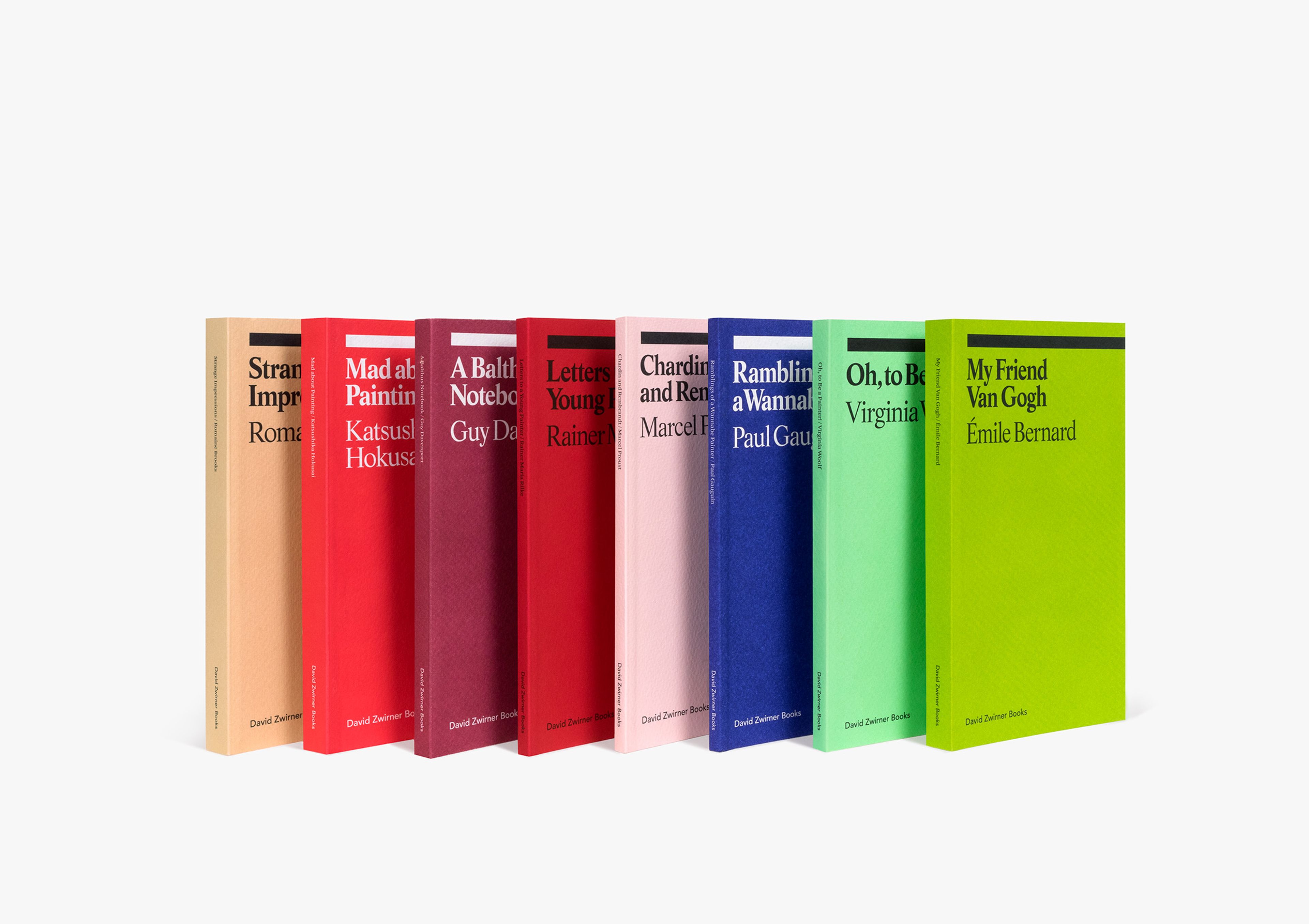
The Painters (ekphrasis bundle)
On Balthus, Chardin and Rembrandt, Van Gogh, and more
Publisher: David Zwirner Books
Publication Date: 2024

From personal letters and memoirs to form-bending essays, these works by painters, novelists, and poets impart many stories of the modern era’s beloved painters, including Hokusai, Van Gogh, and Romaine Brooks.
Included in this bundle: Oh, to Be a Painter! Mad about Painting Strange Impressions Ramblings of a Wannabe Painter A Balthus Notebook Letters to a Young Painter My Friend van Gogh Chardin and Rembrandt

Details
Publisher: David Zwirner Books
Contributors: Émile Bernard, Romaine Brooks, Guy Davenport, Paul Gauguin, Katsushika Hokusai, Marcel Proust, Rainer Maria Rilke, Virginia Woolf, ekphrasis
Publication Date: 2024
ISBN: COL033
Retail: $120
Designer: Mike Dyer
Binding: Softcover, 8 books
Pages: 860
Reproductions: 28 illustrations
Artist and Contributors
Émile Bernard
Émile Bernard (1868–1941) was a French painter and writer known for his contributions to cloisonnism—a post-impressionist style defined by flat plains of bold color and distinct outlines—and his friendships with Vincent van Gogh, Paul Gauguin, Odilon Redon, and Paul Cezanne. He was also a prolific writer of art criticism and poetry: he published his correspondence with Van Gogh and other artists and founded and edited the review La Rénovation esthétique. His works are held in museums worldwide.
Romaine Brooks
Romaine Brooks (1874–1970) was an American painter most known for her muted color palette and deeply personal portraits that challenged conventional ideas of gender and sexuality. Among her sitters were the dancer Ida Rubinstein and the poet and novelist Natalie Barney. She spent most of her life in Paris, where she was a leading figure of an artistic counterculture of upper-class Europeans and American expatriates, many of whom were creative, bohemian, and homosexual. Brooks’s career reached its height in 1925, when her work was exhibited in London, Paris, and New York. In the 1930s, Brooks began work on her autobiography, No Pleasant Memories, which consists of sketches of her troubled childhood, musings on artists’ roles in society, and reflections on her own rejection of the norms and traditions of art. Largely forgotten by art history, Brooks bequeathed a number of her paintings to the Smithsonian American Art Museum, Washington, DC, where recent exhibitions have sparked a renewed interest in her work.
Guy Davenport
Guy Davenport (1927–2005) was born in Anderson, South Carolina, and educated at Duke, Harvard, and Merton College, Oxford. He won the Morton Dauwen Zabel Award from the American Academy of Arts and Letters, was a finalist for the National Book Critics Circle Award, and a MacArthur Fellow. The author of over thirty books of fiction, essay, poetry, and translations, he was also a visual artist who frequently illustrated his own work. A selection of work from the American original polymath can be found in The Guy Davenport Reader (2013).
Paul Gauguin
Paul Gauguin (1848–1903) is one of the most significant French artists of the late nineteenth century, widely recognized for his contributions to postimpressionism. Gauguin’s work is held in museum collections worldwide, and his notebooks and travel journals have been published and translated into many languages.
Katsushika Hokusai
Katsushika Hokusai (1760–1849) was born in Edo (present-day Tokyo), Japan, and was known by at least thirty names during his lifetime. In 1798, he declared his artistic independence and officially adopted the name Hokusai. From that point until his death, he worked in three distinct formats: single-sheet prints, book illustrations, and multicolor paintings. Around 1831, when he was in his early seventies, he produced his most celebrated print series, Thirty-six Views of Mount Fuji, which includes the Great Wave, the painting for which he is best known. Numerous impressions of these works are in public and private collections outside of Japan, and Hokusai’s rich artistic legacy continues to draw attention and admiration around the world.
Marcel Proust
Marcel Proust (1871–1922) was a French writer, critic, and essayist. He is best known for his novel À la recherche du temps perdu (In Search of Lost Time), which was published in seven volumes between 1913 and 1927, and is considered one of the most important literary works of the twentieth century.
Rainer Maria Rilke
Rainer Maria Rilke (1875–1926) was a poet and novelist, best known for his highly lyrical poetry. He was born in Prague, but spent significant portions of his life in Paris, where he initially served as the sculptor Auguste Rodin’s secretary before going on to produce much of his important early work. Throughout his life, Rilke was continuously inspired by works of visual art. His biography of Rodin and his Letters on Cézanne, published posthumously, provide insight into the way visual artists, and their art, figured into his creative approach, and establish him as one of the key twentieth-century poets to engage with visual culture.
Virginia Woolf
Virginia Woolf (1882–1941) was one of the major literary figures of the twentieth century. In addition to her groundbreaking novels, she was an admired literary critic, and authored many essays, letters, journals, and short stories. With her husband Leonard Woolf she founded the Hogarth Press, which would publish some of the most important modernist texts of the twentieth century including her own.
ekphrasis
Dedicated to publishing rare, out-of-print, and newly commissioned texts as accessible paperback volumes the ekphrasis series is part of David Zwirner Books’s ongoing effort to publish new and surprising pieces of writing on visual culture.
$120